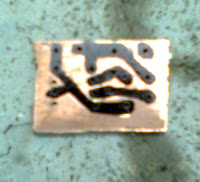Hi friends today i will tell you how to make an automatic street light using LM555 timer ic. The material required are as follows:-
:An LM555 ic
:A 50 Kilo-Ohm Potentiometer
:An LED (white or green)
:FeCl3 Solution
:4 by 4 copper clad board.
:An LDR
:Regulated DC Power supply(+6 Volt)
:Permanent marker
:Hand drill
The circuit diagram of automatic street light is as follows:-
:An LDR
:Regulated DC Power supply(+6 Volt)
:Permanent marker
:Hand drill
The circuit diagram of automatic street light is as follows:-
The pin no. of IC not shown here is not in use.The adjacent picture is the pcb design of the circuit which has to be made by marker on copper clad board.The holes on the copper clad board must be properly drilled at right place with the help of a mini hand drill.The bit used in drill must be at most .5mm dia. After marking the pcb ,it must be dipped into FeCl3 solution properly with care.Now the properly eached(cleaned) pcb is as follows:-
Here is the properly drilled PCBs. Now insert the proper terminals of a particular components in proper holes of pcb. Connect the wires with supply not more then 6volts and 500 ma.Here is the automatic street light :-
Note: positive supply is given to 8th pin no. of ic 555 and negative supply is given to 1st no. pin of the ic.
Also see the following portable model of automatic street light--
http://electronicsprojectsforfree.blogspot.com/p/blog-page.html
Also see the following portable model of automatic street light--
http://electronicsprojectsforfree.blogspot.com/p/blog-page.html
Here is the video:-















